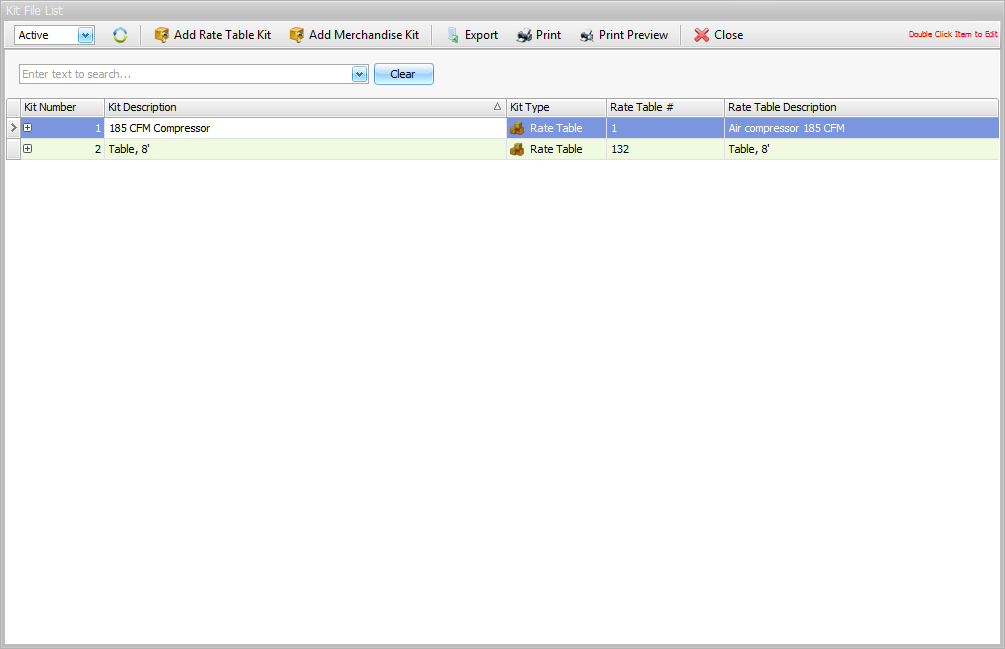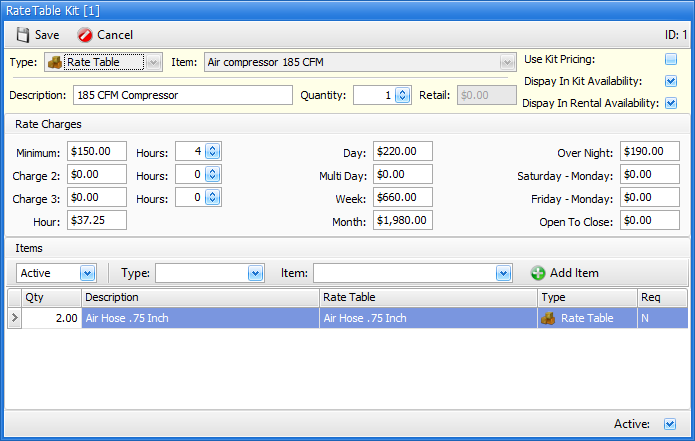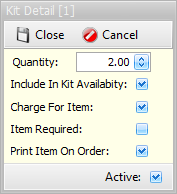2-D from the main menu
Kits are set up to streamline order entry. Kits are not required, but if you consistently rent identical or similar "sets" of items from your rental or sales inventory, setting up kits for these "sets" of items can save you and your customer valuable time. Kits are also useful to help you remember to send items along that, if forgotten, will hinder the customers rental experience. Setting up kits to include gas cans with two cycle engine items, keys with skid steer loaders, and chairs with tables all ensure that you will be building consistent rental contracts for your customers, and also offer you recourse should you customer forget to return items that were rented.
Kit interfaces are found within the order entry process as well as the item lookup/order creation process. While there are differences between these two areas as to how the kits are presented to you, the overall principles remain the same. Kit items are set up as either required or not required, chargeable or not chargeable, and printed or not printed. For every kit there is a PRIMARY ITEM and one or more KIT ITEMS. For both primary and kit items, the kits are controlled by Rate Table, not by individual item. This means that when you are setting up a kit, you are prompted for rental rate tables, not individual items, and as such, any item associated with the rate tables you select will be subject to the rules of the kit. Please refer to the rate table section for a reminder on the relationship between kits and rate tables.
What if the primary item doesn’t exist? Examples of these “intangible items” are maybe tents or sections of scaffold. Of course they exist, but they may not exist as a whole item, and they would not exist if you didn’t have all of the parts and pieces to create them, AND the same parts and pieces may be used to create several different intangible items. Tents and scaffold sections are the combination of many different parts and pieces. Your customer may rent a 20 x 20 tent from you, but really what you are sending the customer is parts and pieces that will end up being a 20 x 20 tent, and those parts and pieces are what you truly have in your inventory. Further, those same parts and pieces that are used to assemble a 20 x 20 tent may also be used to assemble a 20 x 40 tent.
If you created items in your inventory like 20 x 20 tent, and said you had 6 of them, you’d be overstating your inventory. You really don’t have 6 20 x 20 tents, you simply have in your inventory all of the parts and pieces to create a 20 x 20 tent. And even that may not be true, because some of those parts and pieces may be out on rent for a 20 x 40 tent.
So, for examples like this, you would need to set up a rate table for the “tent” or “scaffold section”, then set up a rental item for the “tent” or “scaffold section”. When you’re setting up the RENTAL ITEM, change the type to a “Kit”. Doing so allows you to rent it, but these items are not considered a part of your valuated rental for reporting purposes.
Next question "How will I know if I have a 20 x 20 tent available.” If you use the item search screen to search for Kits, then FocalPoint will search by kit description, not rental item description. The results that are returned will show you potentially how many of each kit could be assembled (based on the number of parts and pieces available), and how many kits would be available (again, based on the number of parts and pieces available)
There is a great webinar on Kits that illustrate this concept quite well. Click here to view the kits webinar (best viewed with Internet Explorer, not compatible with Google Chrome).
When setting up your first kit, it is always a good idea to test the results of your labor. Set up a simple kit, the begin testing the kit to make sure that it is set up the way you intended. Using the Item Lookup / Order Creation function in FocalPoint is a good test arena for kits, and most of the selection processes are done BEFORE a contract is created.
Upon accessing the kit file maintenance program, you will be presented with a list of kits already established.

Double click or Right Click --> Open to open a kit record. You can also Right Click -->Copy to copy an existing kit as a head start to creating a new one.
Buttons across the top of the screen
Add Rate Table Kit
Use to add a kit where the primary item is a rental item.
Add Merchandise Kit
Use to add a kit where the primary item is a merchandise item.
Export
Use to export a list of kits to Excel
Use to print a list of kits to a printer
Print Preview
Use to preview a list of kits. From the preview screen, you can also print or save to PDF.
Close
Use to close the Kit File List.
The Search Bar
To search for a specific kit by kit description, enter the first few characters of the kit description in the "Enter Description to Search" field. The search field also has embedded search capabilities. After double clicking on an existing kit from the list screen, or clicking on the "Add New Kit" button, you will be directed to a secondary "Kits Screen".



